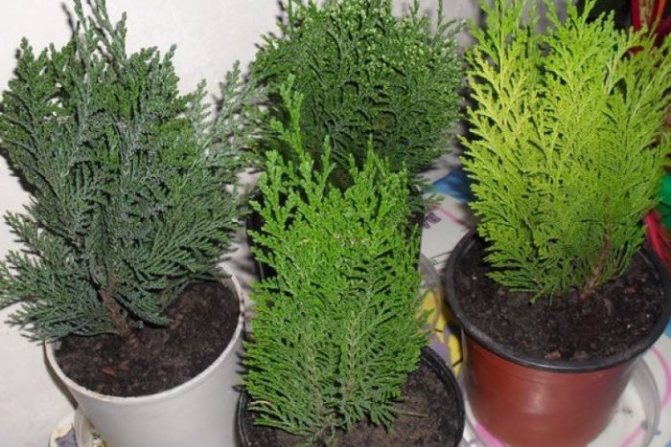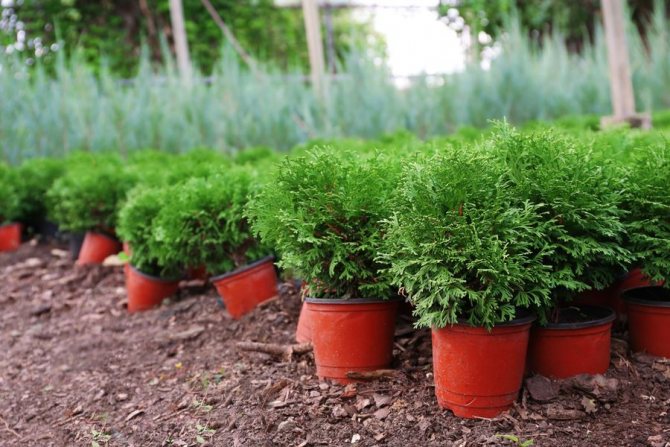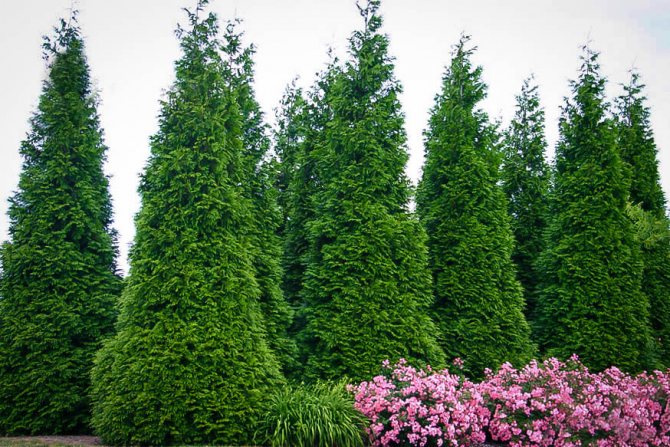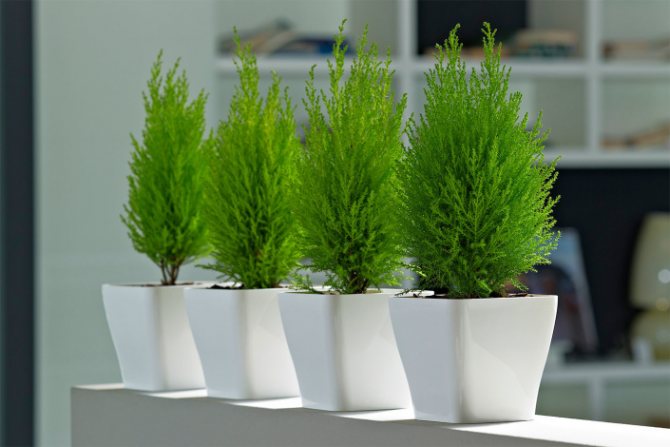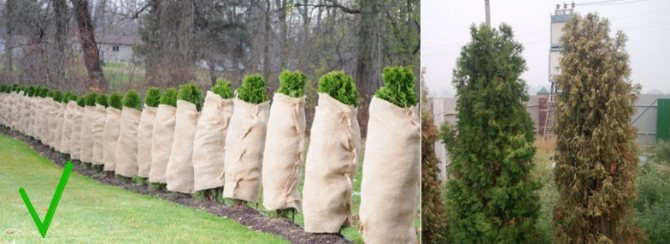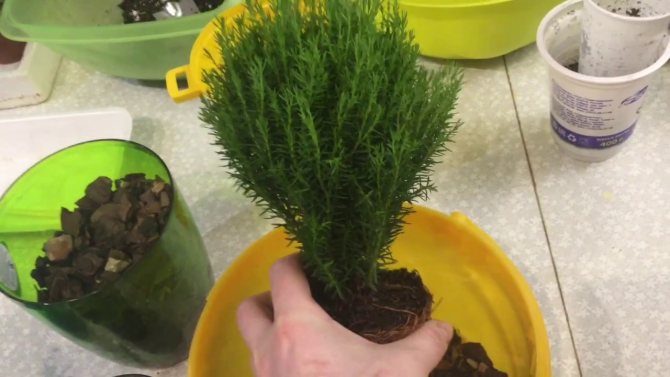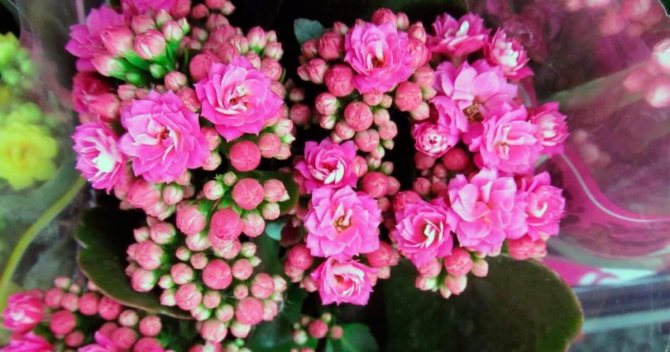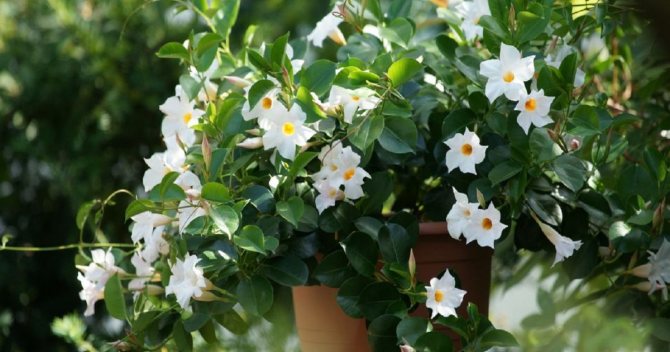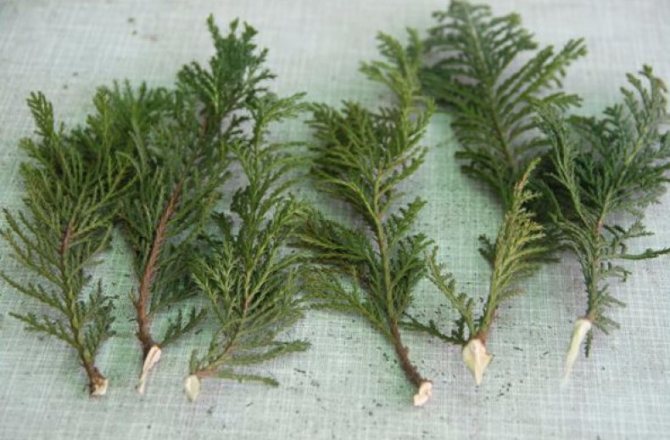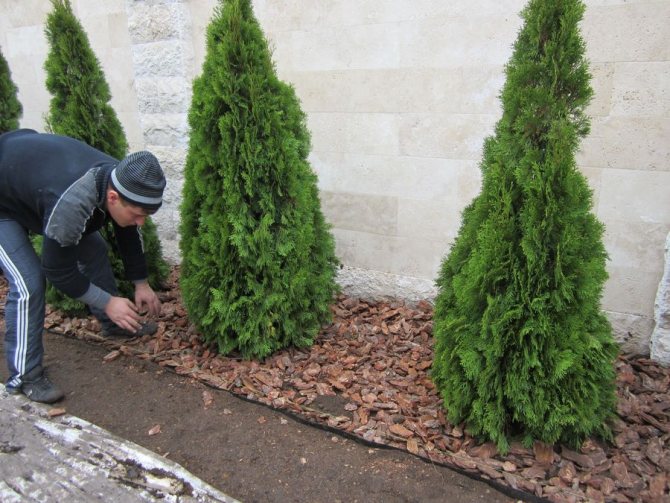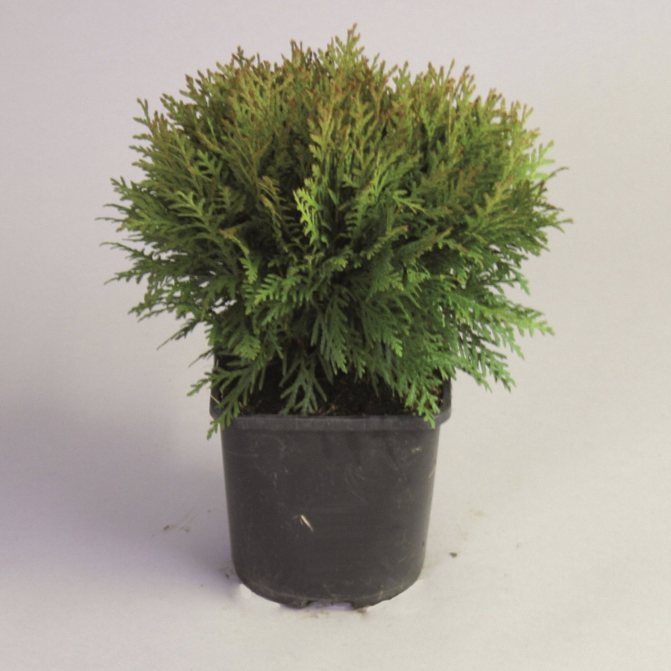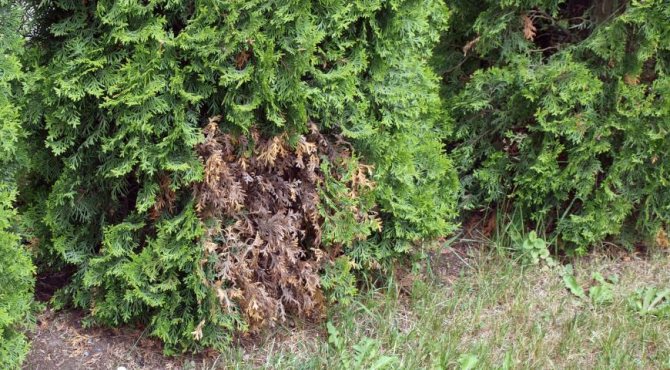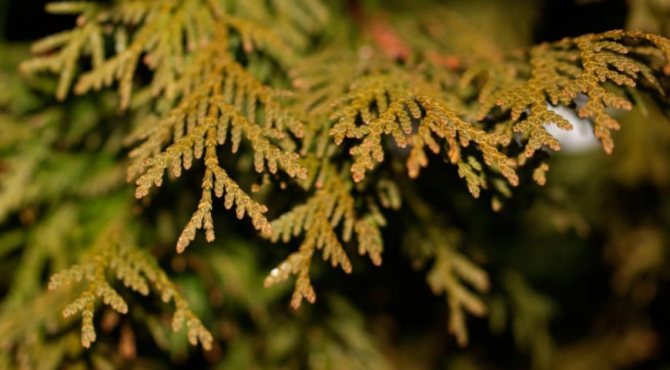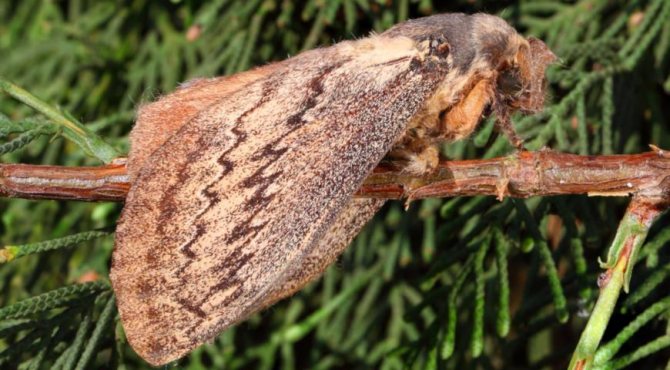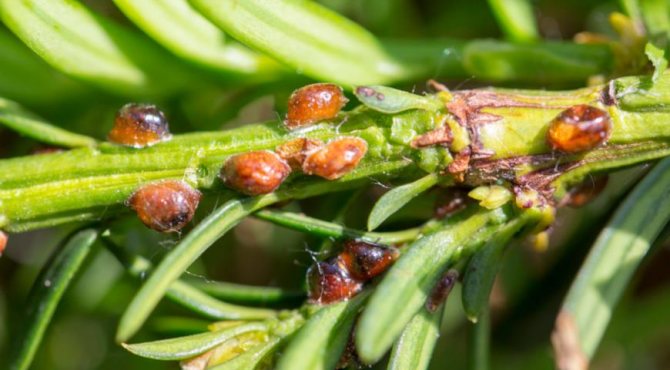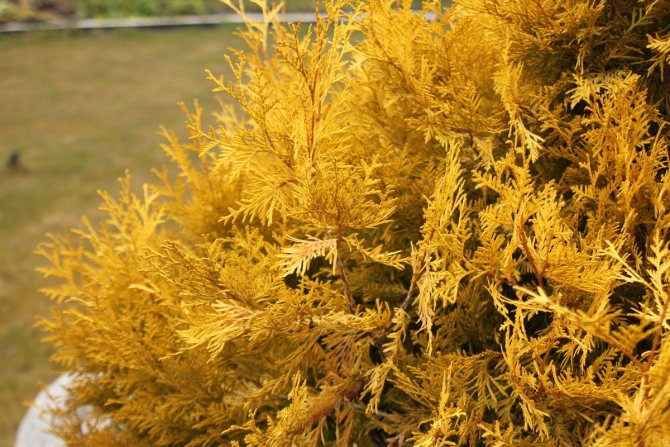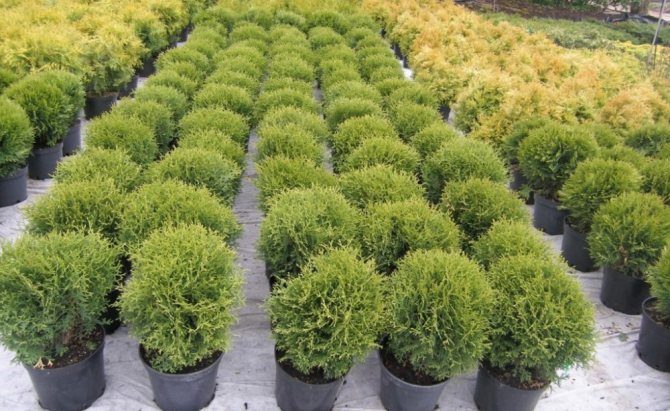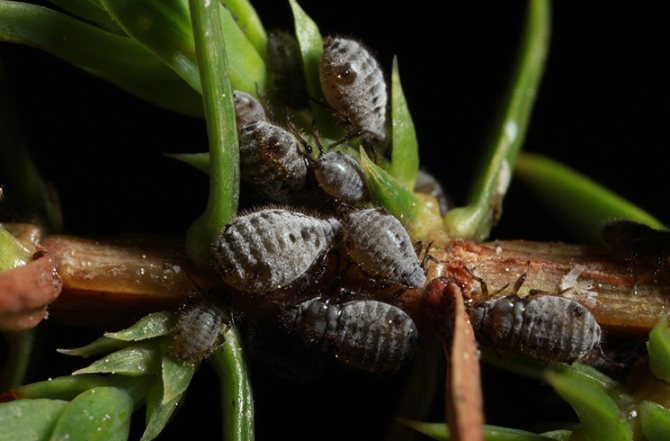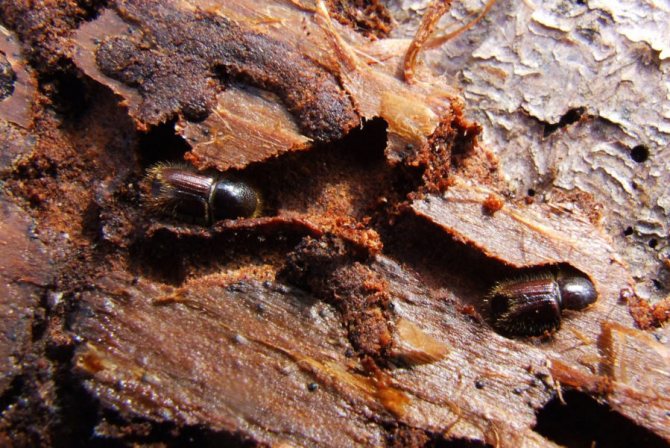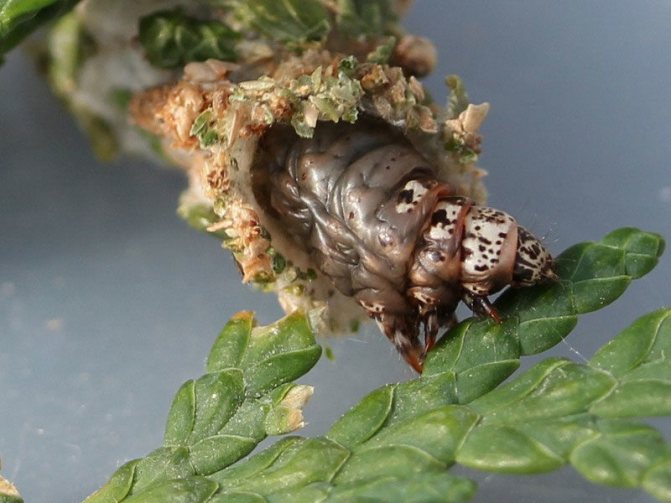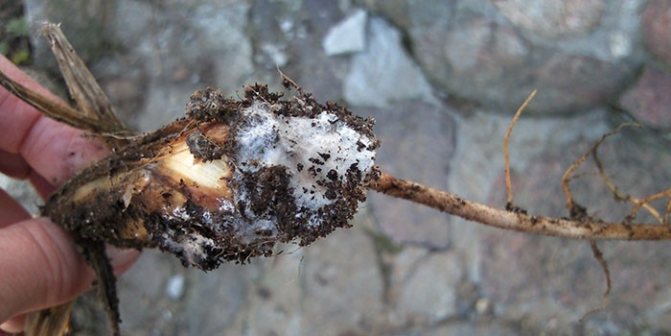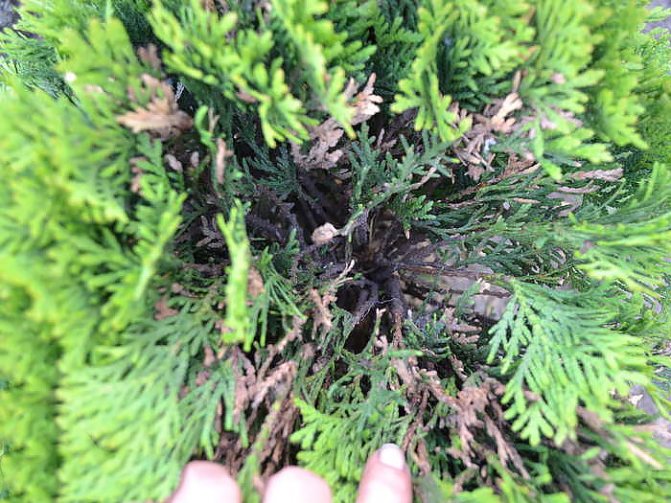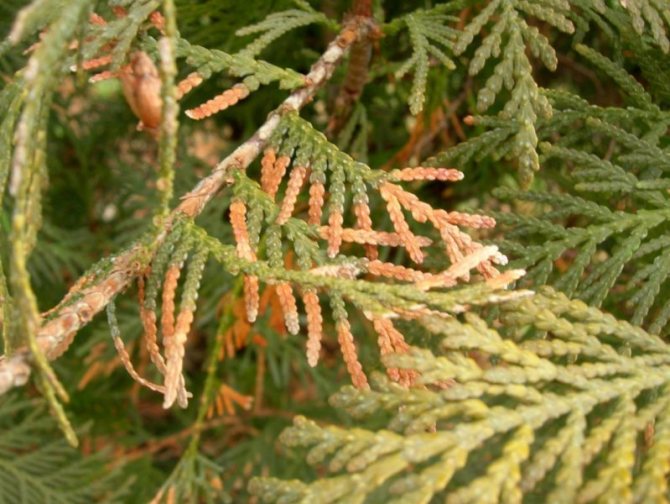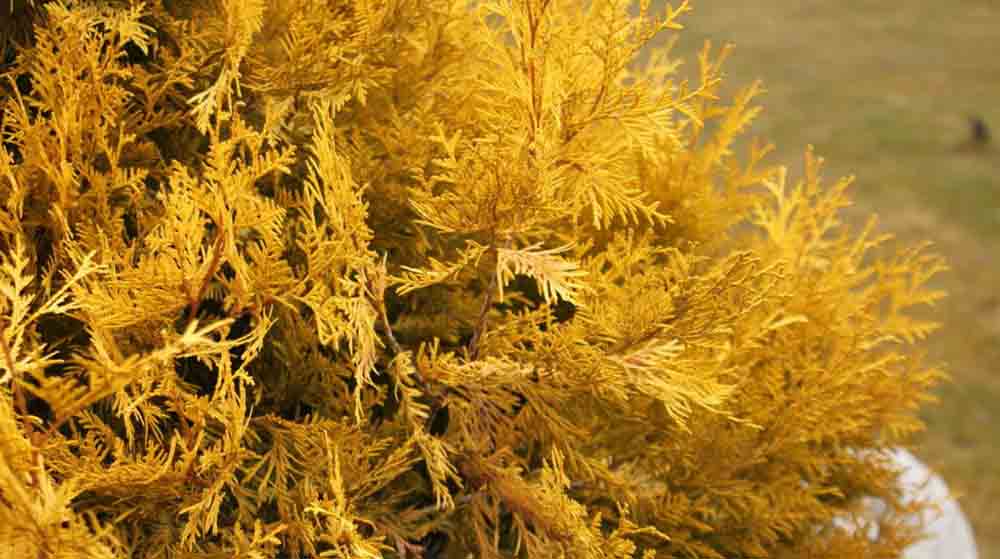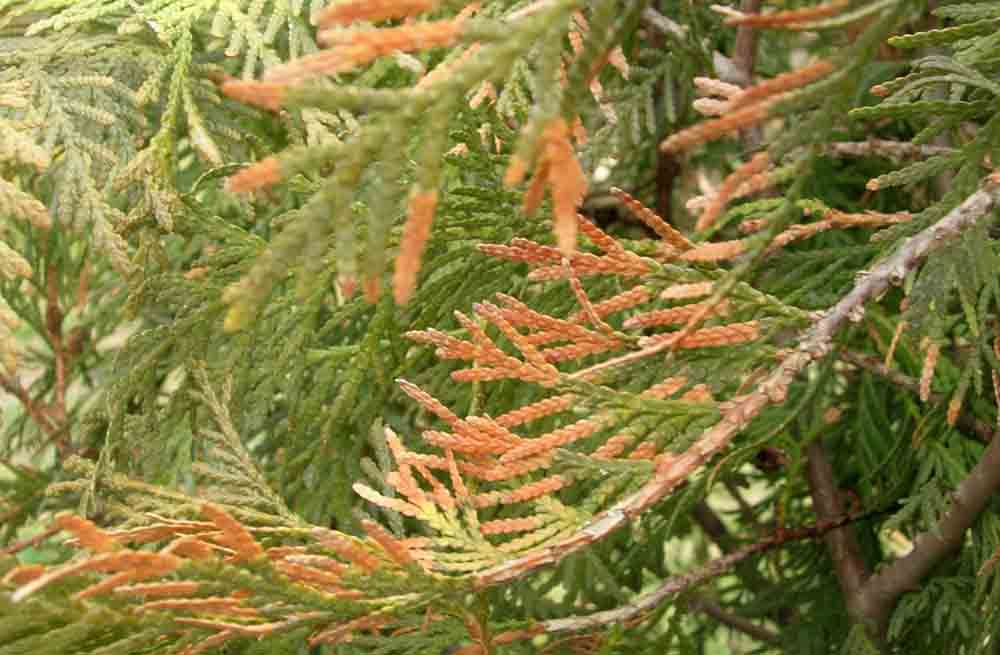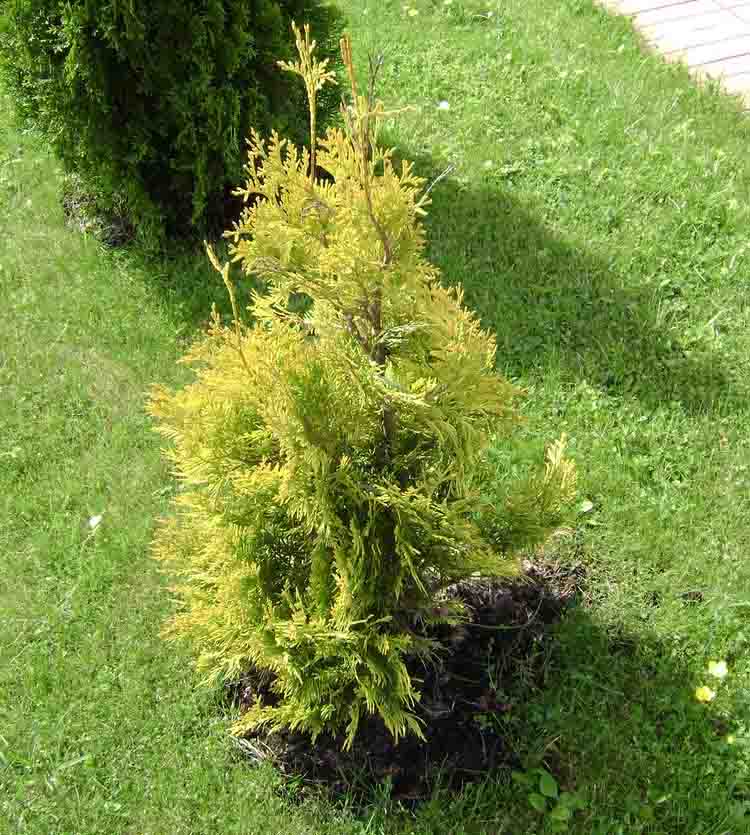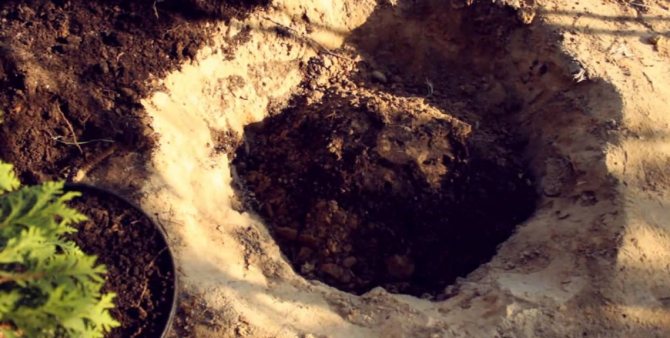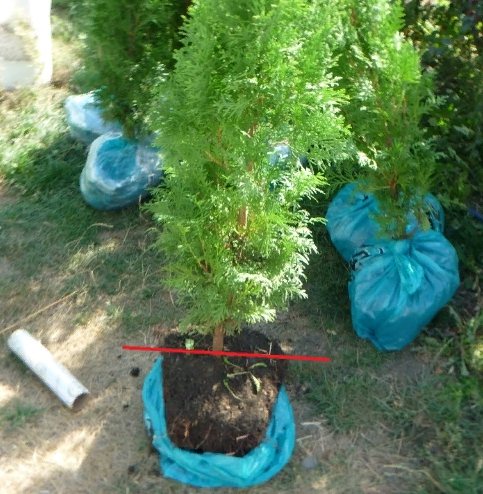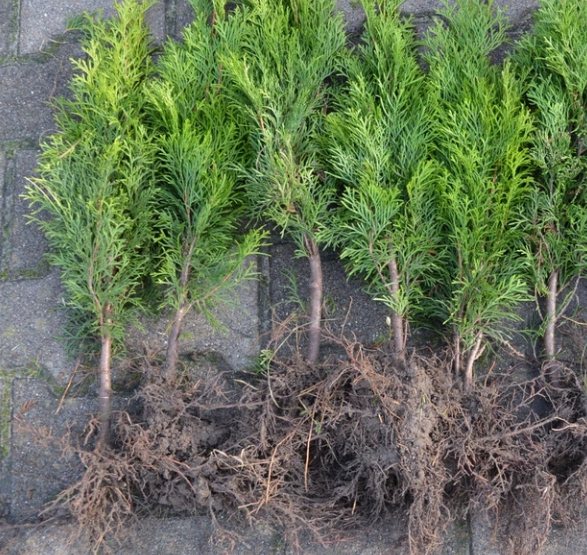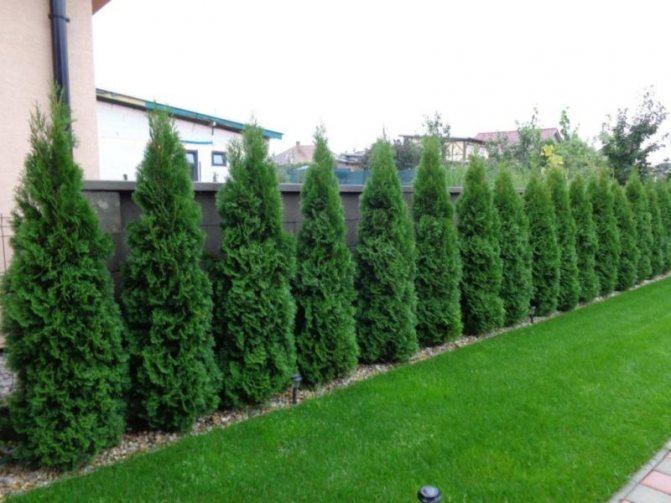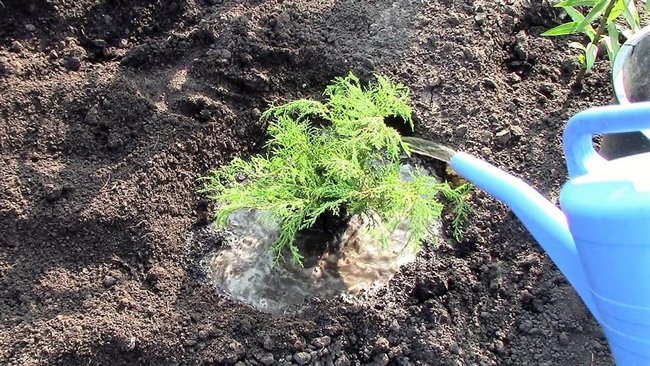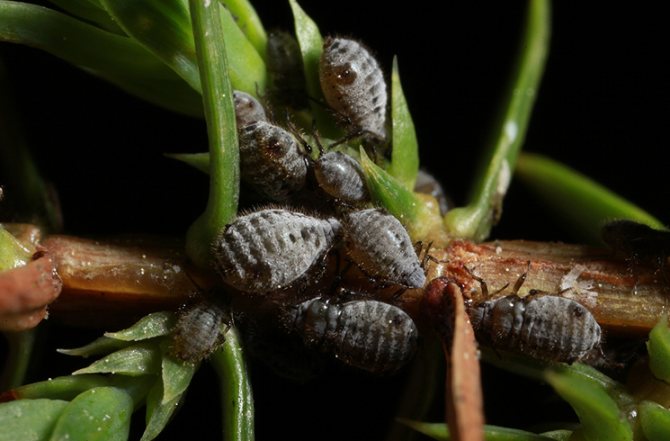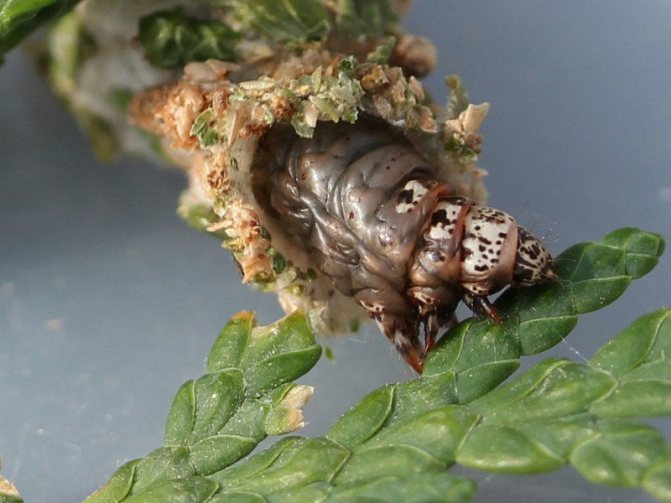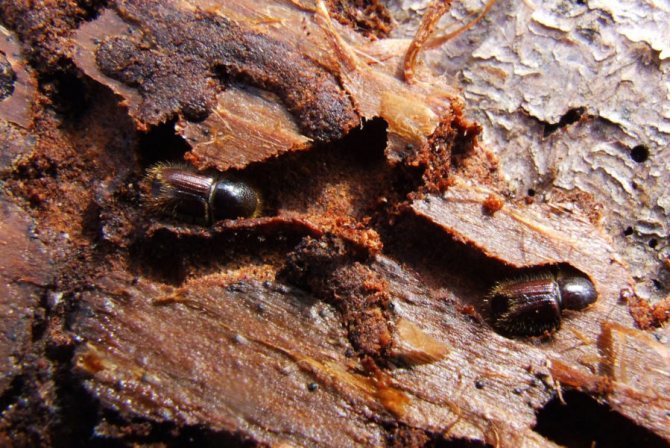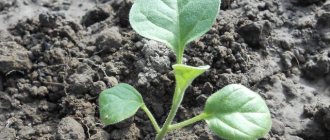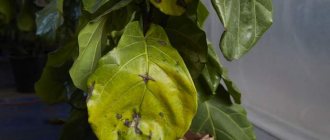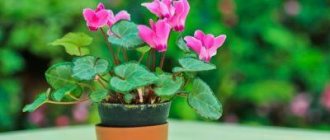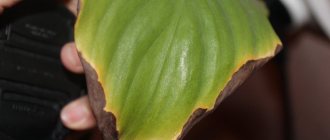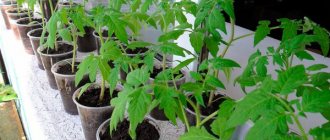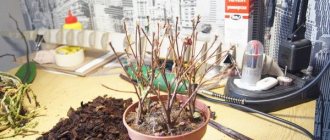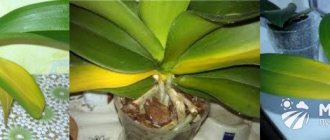What to do to save thuja from drying out
Take a pruner and ruthlessly clean the plant of dry, reddened needles. She herself will not fall, and the tree will never be cleansed. Prune boldly. Sometimes the "final" tree looks creepy, having lost half of the needles.
- Cut off the growing point (shorten the top of the plant by 10-15 cm).
- Purchase sour peat (pH 3-4) and apply a thick layer under the plant. Stir the peat into the topsoil.
- Apply together with the peat fertilizer "Buyskoe coniferous" - the rate of 20 g per plant.
- In the spring, spray the needles with diluted "Epin", after ten days - with "Zircon", after another ten days - with mullein (dilute 1/2 cup in 5 liters of water).
- Admire the bottom line - a partial recovery will occur by the end of the summer. The needles will turn green and vigorously grow.
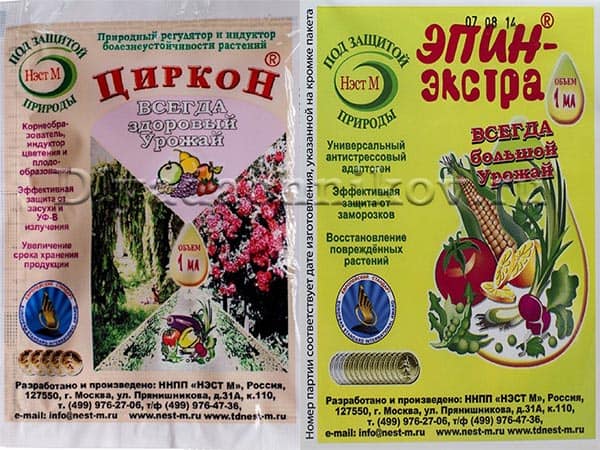
To prevent the thuja from drying out and looking great, it is necessary to spray it with a solution of "Zircon" or "Epin" for prevention. Spray generously to drip from the needles.
You need to repeat spraying of thuja once a month.
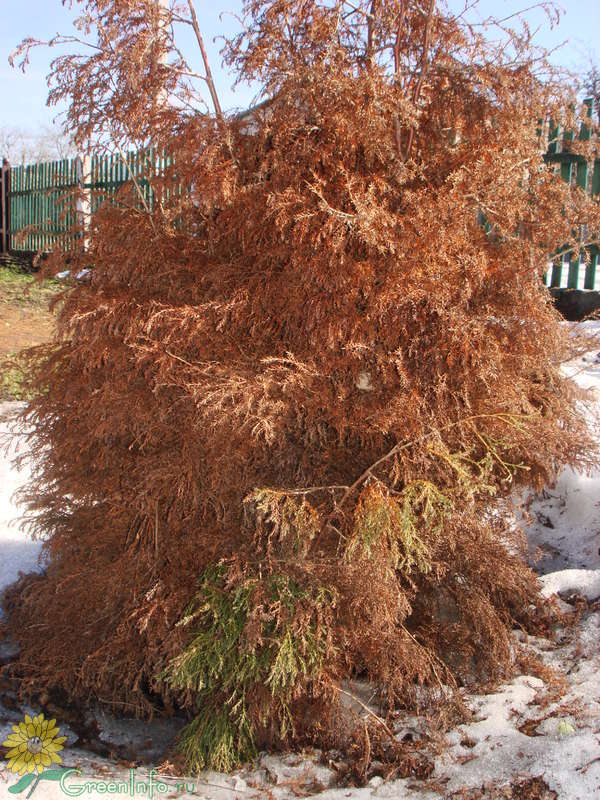

Features of soil care
The condition of the soil for thuja is no less important than protecting the needles from burns. Evergreens like moderately moist, fertilized, loose soils. Stagnation of water for them is destructive, therefore, even during planting, you need to attend to the introduction of drainage into the pit in sufficient quantities.
Growing thuja involves the following work with the soil:
- weed removal;
- loosening;
- mulching.
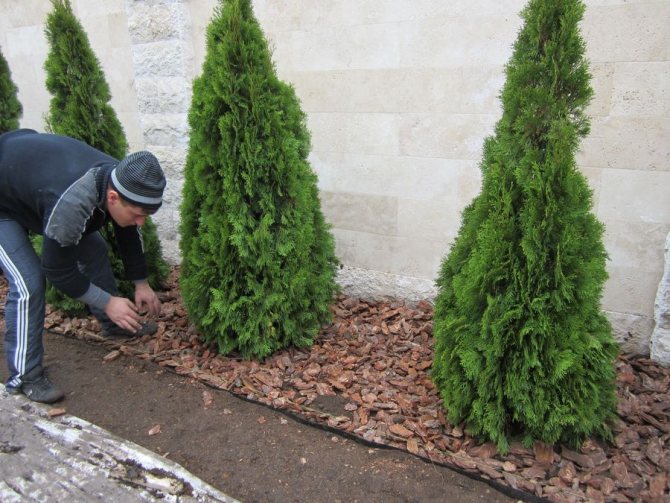

The soil must be clean of weeds... The roots of other plants take away some of the nutrients. In addition, they can be carriers of diseases, attract pests. It is advisable to periodically loosen the soil to improve its breathability and moisture absorption. But do it carefully, without going deeper than 10 cm, since the root system is superficial.
To simplify your work, and at the same time create that favorable conditions for growth, you can mulch the trunk circle... It is allowed to use compost, humus or crushed coniferous bark as a covering material. Mulch stops the growth of weeds, retains moisture, improves the vital activity of soil microorganisms that enrich the composition of the soil.
Thuja feeding
Top dressing is an important component of care. Plants with weak immunity are most subject to diseases. Your pets should be treated with organic matter and fertilization on time. Every now and then they use an infusion of mullein, infused for about two weeks, 3 liters per plant.
Pour the solution near the base of the thuja.
The mistake of most summer residents is that they try to feed the thuja before hibernation. It should be remembered that in late autumn the plants stop growing, and feeding, on the contrary, activates its growth. As a result, young shoots will die in the frost.
For feeding thuja, manure is most often used, it is poured with water (1: 4) and insisted for two weeks. For one plant, approximately 2-3 liters of such an infusion are required. It should not be poured onto the base of the trunk, but onto the soil around the tree.
The larger the thuja, the larger the radius of the circle of the cultivated soil should be. As mineral fertilizers, it is good to use the preparations "Bioud" (for 1 tree 1 kg of fertilizer, used up to three times per season), "Kumir-universal" (for 1 square meter 120 g of the drug), Epin solution (for 5 liters of water 1 ampoule of the drug).
Attention! before the winter period, the plant cannot be fed.
Thuja prepares for rest - the growth of shoots stops, they ripen. And top dressing will stimulate the growth of the tree, young shoots will leave in winter unstable and may die. Therefore, August is the last month when thuja is fed before wintering.
Spring sun rays
One of the main reasons for the yellowing of thuja needles may be the spring sun, whose rays are reflected from the snow that has not yet melted, thereby increasing its intensity. It is not surprising that thuja, just waking up from the winter cold, often gets a sunburn in the spring.
She can only be saved with a covering material that protects her from the sun's rays. Any burlap, spruce branches or kraft paper can be used as a covering material.
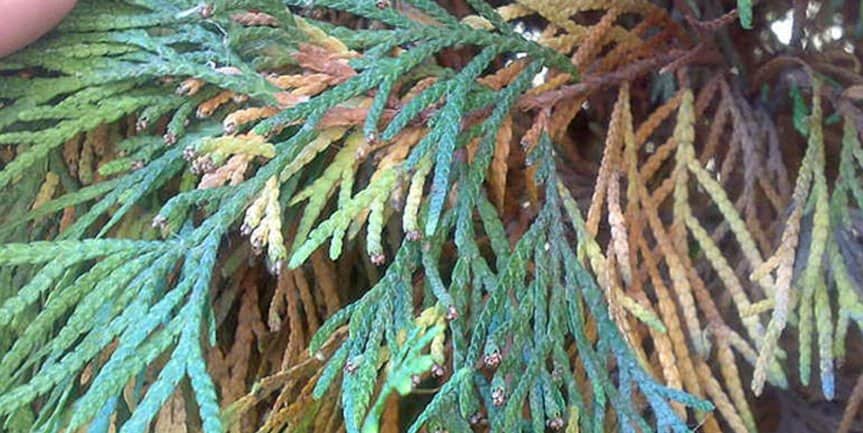

It is advisable to cover it at the end of winter, if there is not enough covering material for the entire shrub, then it can only be covered from the sunny side. But do not cover it completely, it must have access to air.
If she has already received a burn, then in this case she needs to be hidden in the shade and watered more often. Over time, it will definitely grow needles and return its original green color.
Thuja disease control
Many summer residents complain that the thuja in the suburban area for some reason first turns yellow and then dries up. Darkening of the needles is sometimes observed. There may be several circumstances.
The most common reason for the yellowness of thuja needles is early spring burns.
In spring, sometimes the sun is gloriously hot, and the rays of the sun are reflected from the remnants of the snow cover, and from this their intensity increases. After winter sleep, thuja is too weak, its needles are very soft and easily get burns. Therefore, you need to organize a convenient environment:
- Twilight
- Thorough irrigation.
A little time will pass - and the plant will turn green. So that such a misfortune does not bother her anymore, at the end of winter it should be covered from direct rays with some kind of dark, perfectly permeable airflow sealant. All conifers also suffer from fungal diseases.
For this reason, the thuja also turns yellow, and the needles crumble. Pests of the thuja-thuja moth-speckled and thuja aphids. The speckled moth is destroyed with Cypermethrin, and aphids with a solution of Karbofos.
The reasons
Most often, thuja begin to turn yellow after winter. This is due to sunburn, as snow reflects the sun's rays in the spring, thereby increasing its intensity.
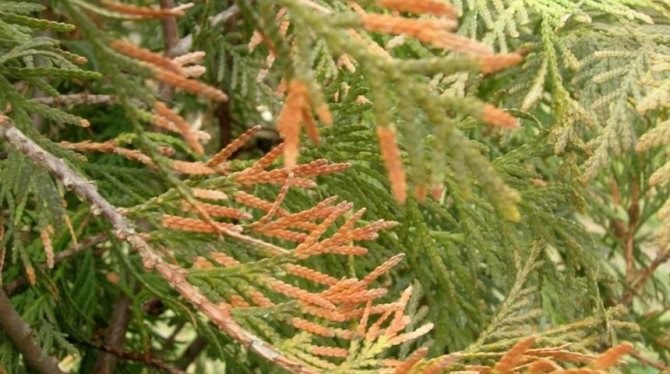

In addition, after winter, the plant experiences a lack of nutrients, which weakens the protective ability of decorative needles. You do not need to worry - with good watering, the thuja will gradually recover itself.
There are other likely reasons for the yellowing of a plant:
- each paw lives for about 5 years, so the thuja periodically drops them. In this case, they turn yellow, dry out and fall off. The number of yellowing paws is minimal.

Natural processes- Plant transplant errors - this species loves sod soil with the addition of sand and peat. In clay soil, moisture stagnates, which provokes its excess, and on the other hand, a lack of nutrients. Too much sand leads, on the contrary, to a lack of moisture. With an excess of peat, the roots of the plant rot - the plant dies. That is, the soil must be balanced.
- Thuja planted too close lack light and begin to turn yellow.
- Lack of nutrients - first of all, it concerns iron. Then individual legs or areas begin to turn yellow, most often young shoots.
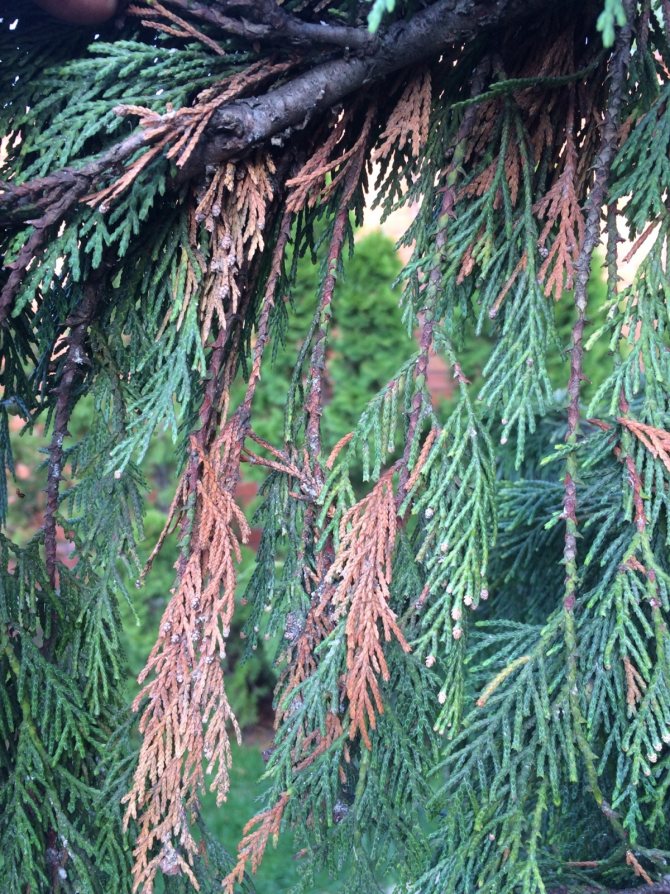

- Ground water - too wet soil or abundant and frequent watering always lead to root rot, which is reflected in the upper part of the plant, which turns yellow.
- sunlight - in an open area with a large number of sunny days, thuja may begin to turn yellow. The risk is increased if needles are transplanted from a dense stand.
- Frosts - Thuja tolerates low temperatures well, but in frosts below -25 ° C, some branches freeze and acquire a brown color. This can be avoided by sprinkling the plant with snow or covering it with spruce branches.
- Pests - needles have many enemies among insects.Usually it is a thuja aphid that sucks out the sap of the plant and leads to the death of the affected areas. The pest can be seen if you look closely - these are large colonies of silvery small parasites. In other cases, it can be: moth moth larvae, leafworm, click beetle, spider mite, thuja bark beetle and false shield. These are large pests and can be seen if the plant is carefully examined.
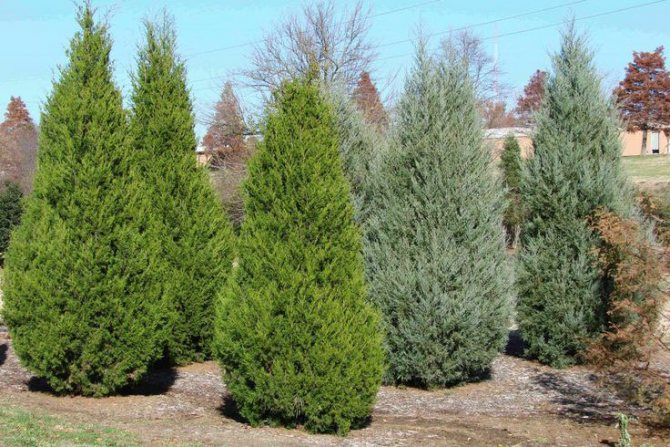

- Fungus - appears at high soil moisture. A serious problem that often leads to the complete death of the ornamental plant. The plant is covered with a bloom of various colors: from light brown to dark gray.
- Diseases - needles are susceptible to various diseases that affect both aerial parts and roots. Among them, most often there are: brown mold, late blight and fusarium. Attention should be paid to the condition of the bark and paws - they become covered with a brown or gray coating, become soft and brittle, and often emit a putrid odor.
What to do if thuja turns yellow
After disembarkation and throughout the season, thuyu should be treated with various bactericidal infusions. The plant needs to be monitored, damaged and yellow dried branches should be cut out in time.
Expert opinion
Victoria Neima
The cut points must be lubricated with a 5% solution of copper sulfate. Unfortunately, anti-yellowing treatment alone is not enough. For prevention, spraying should be carried out in late autumn and early spring.
There is another thuja pest - this is aphid.
Its appearance leads to yellowing, drying and falling of the needles. This insect sucks out all the juices from the young bush, thereby damaging the decorative effect of the thuja. Thuja treatment consists, again, in spraying with insecticides.
Each summer resident should take note that at the end of the growing season, almost all dark conifers, especially thuja, change their color. Looking at the plant, there is a feeling that the tree is drying: the needles are darkening or turning brown. It should be remembered that the sign of yellowness is considered a protective reflex to the coming decrease in temperature and adaptation to winter.
Fungal diseases
Conifers are susceptible to fungal diseases. In a diseased plant, the needles turn and fall off. Therefore, immediately after the thuja was planted in the ground, it must be treated with a foundationol solution (take 10 g of the drug for 10 liters of water). This procedure can be repeated periodically to prevent disease.
The dried branches of the plant must be cut off, and the cut itself must be smeared with a solution of copper sulfate (5%).
Bordeaux liquid will also help to cope with thuja fungal diseases. But one procedure is not enough here. For preventive purposes, the plant must be sprayed at least 2 times a year: in early spring and before the first autumn frosts.
Correct restoration of dried thuja
Experienced gardeners believe that the most common factor in yellowing and shedding leaves is wrong planting. Perhaps the tree is too buried or the main bud of the root has remained uncovered with earth. Another reason for yellowing is insufficient or improper care of the thuja.
After the plant is planted, it must be covered from the sun, and the soil around it should be mulched. If the groundwater is high, the thuja can exist without irrigation. But after planting for a month, watering every week for a bucket of liquid per bush. In dry weather, water a couple of times every 7 days, 20 liters of liquid per plant.
If the heat is unbearable, the bushes must be sprayed with water.
It is recommended to sprinkle with peat chips, sawdust or chips with a layer of up to 5 cm. This must be done in order to exclude overheating and drying of thuja in summer, as well as freezing in winter. If the weather is dry, then to retain liquid in the ground, you can add moss, cut into small pieces. When watering, it will retain moisture around the thuja.
When to open thuja after winter
Although bright green bushes and trees harmonize beautifully with the snow-white cover, experienced gardeners recommend covering all thuja for the winter... For this purpose, a non-woven, light and breathable material is used. If it so happened that with the onset of cold weather the plants were left without shelter, it is necessary to provide them with additional protection in February. At this time, daylight hours increase, despite the low temperature, the sun warms up.
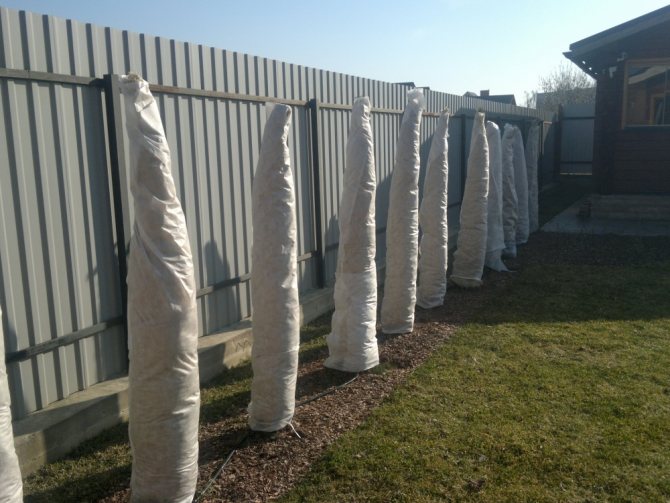

Under the burning rays of spring, the needles wake up, while the root system is still asleep. As a result, active evaporation of moisture occurs. The roots do not compensate for the lost moisture and, as a result, the shoots dry out and turn yellow. It is no longer possible to restore corrupted branches. Therefore, do not ignore the shelter, it helps to preserve the decorative effect of the tree.
It is advisable to open thuja after winter after the awakening of the root system. Snow, or at least most of it, should come off the ground. The most suitable period is when the first buds swell on deciduous trees and bushes. But before that, it is advisable to periodically open the plants in cloudy weather so that they adapt to the light.
Landing features
The thuja plant is unpretentious and can easily take root at any time, but spring is considered the recommended season. Before planting, it is necessary to develop a landscape design, taking into account that the best option is a shaded place. In sunny places it tolerates frost harder, in the shade it grows poorly. Ideally, if there is groundwater nearby, this has a beneficial effect on the tree.
Planting instruction:
- To begin with, for preventive purposes, you need to cultivate the land, which will help to avoid some problems later.
- A hole is dug, about twice as large as a clod of earth with a plant
- The bottom is organically fertilized, ash promotes engraftment
- The roots are sprinkled with a suitable chemical compound, for example, Kornevin, and carefully placed in the hole so that the roots are not outside.
- It is filled up with a mixture of soil and sand and compacted.
There should be some distance between the plants, it all depends on the variety and the final expectation. For a hedge, a minimum distance of 80-100 cm is required, but if you take a step further, then the trees will not have barriers to grow in breadth and develop in height. Watering of the planted plants should be organized, it is also recommended to use top dressing to stimulate growth. This promotes quick and painless rooting and protects against disease. It is also not necessary to pour thuja, in a dry summer, watering is necessary two to three times a week, but if the season is rainy, additional moisture can only harm.
Thuja planting thickened can also cause yellow foliage.
Improper care
What to do if thuja turns yellow and dries from improper care:
Mistake 1. Incorrect soil composition
- clay soil - heavy thuja does not tolerate it well, the roots in such soil do not receive enough oxygen, as a result, the crown begins to wither and turn yellow;
- sandstone - poorly retains moisture, in such soil the thuja will lack moisture.
- How to fix:
- change the composition of the soil - peat, sod land, sand;
- provide a good drainage layer
Mistake 2. Landing level
- strong deepeningroot collar - can cause rotting of the trunk;
- insufficient immersion of the root collar - thuja is susceptible to freezing and warm sun exposure in summer, which leads to drying of the root system.
- when planting, make sure that the root collar remains flush with the ground
How to fix:
Mistake 3.Weak Sapling
If after planting the plant is sick, the cause may be;
- sick seedling;
- or the plant has been outside the soil for a long time.
- when buying, carefully examine the branches - they must be fresh, flexible, not drooping;
- earthy clump surrounding the roots, moist and pliable
How to fix:
Error 4.Distance between landings
Especially often this mistake is made when forming a hedge. The distance between the seedlings must be respected.
How to fix:
- the distance between thuja must be at least 1 m;
- if the thuja were planted densely, while the trees are young, you can plant
Mistake 5. Excessive humidity
- poor drainage system leads to accumulation of water;
- as a result - decay of the roots and yellowing of the needles.
- provide moderate watering;
- think over a good drainage system
How to fix:
Error 6.Drought
Many varieties of thuja do not tolerate dry periods poorly:
- the plant begins to wither;
- branches become weak and lethargic to the touch;
- the color of the crown changes to brown or brown.
- provide the plant with regular watering;
- This is especially true of the spring period, when the thuja's vegetative processes are resumed
How to fix:
Mistake 7. Burns in early spring
With the increased activity of the sun in the second half of February on unprotected thujas, characteristic brown spots may appear - sunburn.
How to fix:
- only preventive measures will help - the plant from the sunny side is covered with a shield (cloth);
- twigs with yellowed needles do not need to be cut off immediately;
- if the damage is not strong, after some time after winter, the needles will return their color
Mistake 8. Oversupply of fertilizers
- an excess of nutrients and minerals in the soil is just as harmful to the plant as a deficiency - in both cases, thuja can get sick;
- iron deficiency affects the condition of the needles most of all - the needles turn yellow, the tree slows down growth and development;
- fresh manure applied as a top dressing can burn the roots, which also causes a change in the shade of the needles;
- with a lack of phosphorus, the crown of the thuja becomes reddish-purple.
- if possible, hand over soil samples for chemical analysis and, based on its results, take appropriate measures;
- feed with complex fertilizers for conifers, guided by the principle - "less is better, or a measure in everything"
How to fix:
|
|
|
|
|
Correct pruning of thuja
You should not forget about pruning. Dry and yellow parts of the plant should be removed annually in spring. Timely haircut will allow you to preserve the beautiful appearance and dimensions of the picturesque fence. It should be formed after the plant reaches the desired height. It is not worth cutting off a lot of needles at once, so that the bush does not weaken.
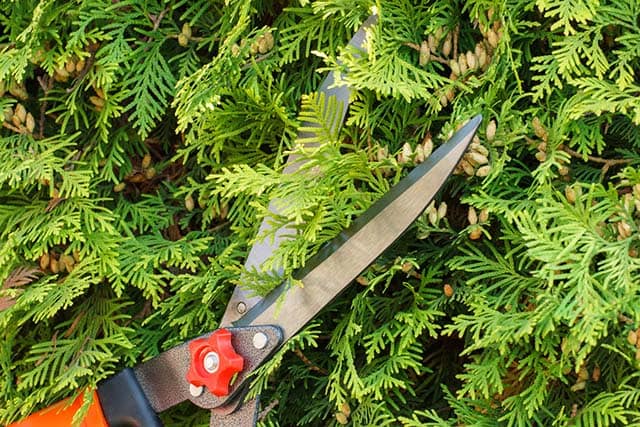

If the thuja is young, then it is necessary for a year or two to be given the opportunity to take root and determine whether it is good enough for it in this place, or is it worth looking for the most suitable one for transplantation. When pruning, you must follow the rules:
- pruning should take place in the spring and just adjust the shape before frost;
- pruning is recommended in dry weather;
- you need to carefully cut off the dried branches and cut some healthy ones to get air;
- if as a result it should not be high, but wide thuja, for example, under a hedge, cut the top of the head by a couple of cm.
Pests
The reason why thuja has brown branches may be pests. Thuja, like many coniferous plant species, is attacked by insects.
Thuja pests:
Thuy bark beetle
It feeds on thuja bark. The attack of this pest can lead to the death of the plant. It is difficult to remove the beetle.
Treatment:
- pheromone traps are hung on trees;
- as insects accumulate near them, the tree is uprooted and destroyed (it is better to burn it)
| Thuvaya aphid Small insect, grayish color. Mainly damages the lower branches. Consequence - the needles turn yellow, dry and fall off. Treatment: spray the plant, especially carefully in places where aphids accumulate, Karbofos |
| Thuvaya speckled moth It settles in the lower part of the trunk and near-stem parts of the branches, sucks the juice from the needles. Treatment: spraying with Karbofos | |
| Mayfly bagworm The caterpillar feeds on needles and small, young twigs of thuja. In places where the pest accumulates, the needles fall off. The plant withers away, becomes available to other pests. Treatment: spraying with Karbofos |
| Weevil beetle It feeds on the bark and needles of young plants. Active in the spring. Treatment: 1. Watering the root circle with Aktara or Antichrusch insecticides. 2. Spraying the crown with Confidor | |
|
Wintering thuja
Although thuja is a frost-resistant plant and does not require special care in winter, it is still necessary to prepare it for frost. In order for the tree to grow somehow in winter, it is recommended to water it fairly in the fall. Young thuja in the first years need insulation, the greenhouse film is perfect for shelter. The heat will remain, and the sunlight will show through. To protect the roots, foliage is laid.
Adult plants should not be insulated, but winter with abundant snow can damage the dense and lush top, break branches. Therefore, in the fall, several tops of small thujas can be pulled together with a rope, and large ones - with a coupler. Such simple rules will provide an opportunity to admire the beautiful bushes all year round. If you follow all the rules for care, thuja will delight the eye and become a real decoration of the site.
Transfer to the garden
A well-groomed thuja can suffer during overwintering and even remain completely naked. Regular care and spraying will give the result: thuja will grow safely for many years.
A change in the color of thuja needles occurs for many reasons, sometimes it is difficult to establish them. Most often, the needles turn yellow, dry, die off and fall off. Examine the thuja carefully to find out what happened to your favorite conifers.
Natural causes
Sometimes the needles of a thuja turn yellow in the fall, because, like all conifers, its lifespan ends. Usually, 3-6 years after the appearance of the needle, it begins to lose chlorophyll grains, brightens, turns yellow and dies. It is replaced by another. In this case, individual branches turn yellow in the inner parts of the crown around the trunk and gradually fall off. This is a normal process.
Seasonal color change
Species plants (Thuja occidentalis
) and folded thuja (
T. plicata
). Needle varieties
Brabant
,
Columna
and
Holstrup
only slightly colored brown, and the beautiful, lush needles of the variety
Smaragd
even in severe frosts, it retains its rich green hue. Darkening or browning of thuja needles is a kind of defensive reaction to a cold snap and adaptation to cold winters that prevail in her homeland - in the western and eastern parts of North America.
With the arrival of spring and the beginning of sap flow, such needles again gain a juicy green color. If this did not happen in the spring, you are facing a more serious problem than the natural physiological characteristics of thuja. But it must be remembered that in spring it can arise on thuja.
Errors when planting thuja
Unfavorable conditions that cause yellowing and shedding of needles, drying of the branches of the lower tier and death of thuja:
- Planting thuja on, where water and nutrients quickly go to the lower layers;
- Planting thuja on, where there are not enough nutrients, the structure is dense, there is not enough oxygen and the root system of the thuja cannot fully develop;
- Planting a thuja in low areas with stagnant water, where the root system of plants becomes blocked and rots.
5. Sharp exposure of thuja to light leads to lightening of the needles to a straw color. Saplings taken from a dense planting or from the shade burn in the sun, often during the first days after planting.
6. Technical salt for cleaning roads and brown the tips of the shoots at the bottom of the plants. Similar damage is caused by the application of an excessive amount of fertilizer.
Animals
The needles and bark of branches on the thuja can turn black (less often red) and dry out. When trees are constantly marked, a black bloom appears on the thuja.
The urine of other mammals is also capable of seriously damaging the root system of even very large woody plants. So, sometimes thuja suffers from cat urine.
For the treatment of necrotic diseases and vascular wilting in spring and autumn with 1% Bordeaux mixture or its substitutes (Abiga peak, HOM
).
In case of severe damage in the summer, spraying is repeated with one of the same drugs. To combat stem rot, the affected areas are cleaned, disinfected wounds, cuts, frost holes and mechanical damage with a 1% solution of copper sulphate and covered with natural linseed oil, garden varnish or pastes. Saw dead trunks and individual trees with a binding.
Sucking pests
Faded, brown thuja needles, covered with a gray-black bloom, or crawling along the needles in mass, may indicate the settlement of the plant. For example, thuja aphids, bedbugs, thuja false shield or juniper. Thuya false scutes look like large brown buds or brown balls (up to 3 mm in diameter), and juniper scutes look like small scars or scabs. On a branch, they can be found more often at the base of the current year's shoot from the lower side. Sometimes, at the base of the branches, white cotton-like formations are found - this is a mealybug. These insects not only suck out the juice from the needles, but also contaminate the surface with paddy, and contribute to the transfer of viral diseases.
The needles that have turned yellow and have not restored their normal color in the spring, the dying off of the tops of the shoots of the thuja give out the thuja. Its larvae eat short burrows in the needles and in the shoots of the thuja. You can identify this butterfly by the presence of exit holes or cavities in the needles. To do this, cut the damaged needles or inspect them in the light. In May, in the crowns of moth-damaged thuja, one can observe a massive summer of butterflies.
The massive fall of needles and "bags" of hard silk 5 cm long, hanging like decorations from the shoots of thuja, are evidence of its colonization by the caterpillars of a butterfly - the mayfly bagworm.
If individual thuja needles become covered with yellowish spots, later turn brown, crumble, and at the same time are entangled in a thin sparse cobweb, and the degree of damage increases sharply by the end of summer - the thuja is populated.
Larvae of gray larch can weave thuja needles into small sloppy cocoons, damaged needles turn yellow. Weevil beetles (skosari) gnaw the bark of young shoots of thuja, as a result of which the tips of the shoots become brown.
Stem pests
Any change in the color of the needles can indicate the colonization of the plant with stem pests. On the thuja, the thuja bark beetle and the Crimean thuja bark beetle develop. Their presence can be understood by the entrance holes in the bark and bizarre passages on wood, under pieces of bark or on their inner side.
Sprayed Karbofos
before bud break, at the end of June they are treated twice
Aktellikom
or
Rogor
with an interval of 10-14 days. From aphids, gray larch leafworm and stem pests in spring in May - early June, one of the drugs:
Fufanon
,
Actellic
,
Decis Profi
... With a large number of pests, they carry out eradication spraying with the same drugs in the summer. In case of severe damage by stem pests, dried branches are cut off, cuts and cuts are covered with oil paint on natural drying oil. If holes are found in the bark of trees, injections are carried out with the drug
Actellic
(without dilution): 1 ampoule / 1 sq. m of the trunk bark - drop by drop into each hole.
Go to article.
Conifers are unpretentious and durable. But even these mighty giants are subject to all sorts of diseases.
The article will tell you about thuja diseases, why thuja turn yellow and how to treat them.
Why does thuja dry in a pot. Leaves dry: causes and their elimination
If the thuja turns yellow and dries up, it is necessary to decide what to do, how to help, as soon as possible, otherwise the plant may simply die. The first step in solving a problem is to establish the root cause.
There are a lot of reasons why thuja dries:
- pests;
- illness;
- burn;
- excess of applied fertilizers;
- insufficient or excessive watering;
- poor care.
The fight against them is as follows.
Special chemicals are used against pests. If the thuja is infected with a false shield (small insects of 3-5 mm, located on the back of the needles, cause the plant to dry out and wilt), apply the Commander, Champion, Decis. With a spider mite, use Aktofit, Aktellik.
Thuja burn
Diseases in which thuja is able to dry out and wither: late blight, brown shoots and fusarium. With late blight, there is no chance of a cure; fungicides are used for prevention. Drying and subsequent dying off occurs with brown shoots, while the affected areas are eliminated, and the tree is systematically sprinkled with limestone, for prophylaxis, from mid-June to the end of September, the tree is sprayed with foundation. Watering at the root of a 0.2% solution of foundationol helps against fusarium.
If the cause of the burn is not eliminated, in which the needles become brown, then over time most of the plant can dry out. The following protective measures are taken:
- the near-trunk circle is covered with peat chips and ash, to reduce the reflection of sunlight;
- the use of special tools to obtain shading.
When overfeeding thuja, there is practically no way to help, you need to wait a while and until you stop fertilizing the plant.
Important! Fresh manure is absolutely not suitable for fertilizing, it will ruin the entire plant.
Thuja dries up how and what to do in this case - this is a question that needs to be raised at the very initial stages of plant damage. Large foci of yellowed or dried needles cause tremendous damage to the entire plant, and, perhaps, no rescue manipulations will help. The main thing is to provide thuya with proper, full-fledged care, then such a problem as yellowing of the needles will never appear.
Indoor decorative thuja is a neat bushes of a wide variety of shapes. It is called the tree of life for its ability to purify the air and energy of the room in which it is located.
Few know that the thuja plant does not have a room type. What flower growers call decorative thuja, in fact, is not a thuja. The Vostochny ploskovetochnik is the only representative of the genus Ploskovetochnik (Platycladus, Biota) of the Cypress family. In some sources, it can be found as Eastern Tuyu. This name is associated with the previous position of the plant in the systematic classification.
Florists love Ploskovetochnik for their exotic appearance and unpretentiousness. Caring for room thuja does not require special skills and at home this plant takes root very well. And the variety of possibilities for crown formation gives the flower an additional charm.

